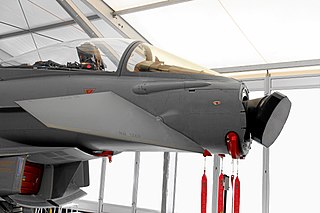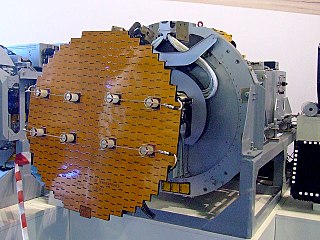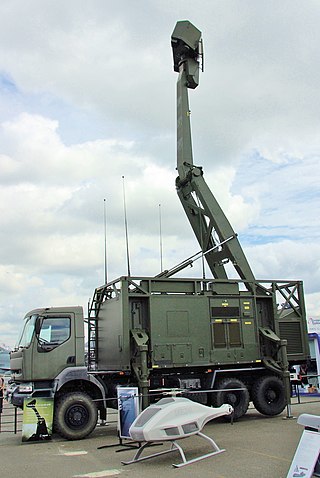External links
| Armed Forces |
| |||||||||||||||
|---|---|---|---|---|---|---|---|---|---|---|---|---|---|---|---|---|
| Other | ||||||||||||||||
| Country of origin | Iran |
|---|---|
| Type | Passive radar |
| Range | 300 km (190 mi) |
Alim is the first Iranian passive radar. Passive radars do not transmit. Instead, they detect and track objects by processing reflections from non-cooperative sources of illumination in the environment, such as commercial broadcast and communications signals.
Alim is cheaper and has lower maintenance cost than conventional radars because it lacks a transmitter and movable mechanical parts. It requires high processing power, as six levels of processing are needed to track targets. Other advantages include the ability to detect low RCS targets at low altitudes. Since it doesn't transmit, it is immune to anti radiation missiles such as American AGM-88 HARM, thus it can be deployed near enemy lines.
It was first seen in 2011 during the parade of Iranian armed forces. The radar has a range of between 250 and 300 km and is able to detect slow, low flying targets with relative ease. [1]

Radar is a system that uses radio waves to determine the distance (ranging), direction, and radial velocity of objects relative to the site. It is a radiodetermination method used to detect and track aircraft, ships, spacecraft, guided missiles, motor vehicles, map weather formations, and terrain.

Sonar is a technique that uses sound propagation to navigate, measure distances (ranging), communicate with or detect objects on or under the surface of the water, such as other vessels.

An active electronically scanned array (AESA) is a type of phased array antenna, which is a computer-controlled antenna array in which the beam of radio waves can be electronically steered to point in different directions without moving the antenna. In the AESA, each antenna element is connected to a small solid-state transmit/receive module (TRM) under the control of a computer, which performs the functions of a transmitter and/or receiver for the antenna. This contrasts with a passive electronically scanned array (PESA), in which all the antenna elements are connected to a single transmitter and/or receiver through phase shifters under the control of the computer. AESA's main use is in radar, and these are known as active phased array radar (APAR).

The Kolchuga passive sensor is an electronic-warfare support measures (ESM) system developed in the Soviet Union and manufactured in Ukraine. Its detection range is limited by line-of-sight but may be up to 800 km (500 mi) for very high altitude, very powerful emitters. Frequently referred to as Kolchuga Radar, the system is not really a radar, but an ESM system comprising three or four receivers, deployed tens of kilometres apart, which detect and track aircraft by triangulation and multilateration of their RF emissions.

A pulse-Doppler radar is a radar system that determines the range to a target using pulse-timing techniques, and uses the Doppler effect of the returned signal to determine the target object's velocity. It combines the features of pulse radars and continuous-wave radars, which were formerly separate due to the complexity of the electronics.
A low-probability-of-intercept radar (LPIR) is a radar employing measures to avoid detection by passive radar detection equipment while it is searching for a target or engaged in target tracking. This characteristic is desirable in a radar because it allows finding and tracking an opponent without alerting them to the radar's presence. This also protects the radar installation from anti-radiation missiles (ARMs).

The Raytheon MIM-23 HAWK is an American medium-range surface-to-air missile. It was designed to be a much more mobile counterpart to the MIM-14 Nike Hercules, trading off range and altitude capability for a much smaller size and weight. Its low-level performance was greatly improved over Nike through the adoption of new radars and a continuous wave semi-active radar homing guidance system. It entered service with the US Army in 1959.
Passive radar is a class of radar systems that detect and track objects by processing reflections from non-cooperative sources of illumination in the environment, such as commercial broadcast and communications signals. It is a specific case of bistatic radar – passive bistatic radar (PBR) – which is a broad type also including the exploitation of cooperative and non-cooperative radar transmitters.

The Saab Giraffe Radar is a family of land and naval two- or three-dimensional G/H-band passive electronically scanned array radar-based surveillance and air defense command and control systems. It is tailored for operations with medium- and Short Range Air Defense (SHORAD) missile or gun systems, or for use as gap-fillers in a larger air defense system.
Radar MASINT is a subdiscipline of measurement and signature intelligence (MASINT) and refers to intelligence gathering activities that bring together disparate elements that do not fit within the definitions of signals intelligence (SIGINT), imagery intelligence (IMINT), or human intelligence (HUMINT).

The Swathi weapon locating radar is a mobile artillery-locating, phased array radar developed by India. This counter-battery radar is designed to detect and track incoming artillery and rocket fire to determine the point of origin for counter-battery fire.

The Unattended Ground Sensor (UGS) are a variety of small sensors, generally covert, dedicated to detect and identify activities on the ground such as enemy soldiers or vehicles. UGS come as systems with an integrated communication network and processing capabilities.

The PJT-531 Battle Field Surveillance Radar – Short Range(BFSR-SR) is a man portable 2D short-range battlefield and perimeter surveillance radar developed by the Indian Defence Research and Development Organisation (DRDO). The BFSR has been designed by DRDO's Bengaluru-based laboratory, the Electronics and Radar Development Establishment (LRDE) and is being manufactured by Bharat Electronics Limited (BEL).

Bavar-373 is an Iranian long-range road-mobile surface-to-air missile system unveiled in August 2016. Iran describes it as a competitor of the S-300 missile system. It is manufactured by the Iranian Defence Ministry in cooperation with unspecified local manufacturers and universities.

Matla-ul-fajr is an Iranian VHF 3D radar. It was first seen in military parades. It was stated that Matla-ul-fajr covered the whole Persian Gulf. The range of Matla-ul-Fajr-1 is 300 km and the max altitude is 20,000 m. When fully set up, the height of the system reaches eight meters and it uses 12 "Yagi" antennas installed in two rows. The whole system, containing the antennas, setup instruments, processing, controlling and displaying units, communication devices and power generator are all installed on a trailer to achieve a very good mobility. The radar is also equipped with ECCM to survive in an e-warfare environment.

Kashef is a series of Iranian early warning radars developed by SAIRAN. Currently there are three versions in service, Kashef 1, Kashef 2 and Kashef 99.

The TRML is a family of air defense radars first developed by Telefunken and currently produced by Hensoldt. It is a development of the earlier TRMS.

Asr is an Iranian passive electronically scanned array long-range radar unveiled in 2013. The Air Surveillance Radar or ASR is a 3-D solid state phased array radar, capable of detecting boats, low flying aircraft with a radar cross section (RCS) of 4 m2 (43 sq ft) at a range of 5–110 nmi. The radar is jointly designed and built by the Islamic Republic of Iran Navy and the Ministry of Defence and Armed Forces Logistics (Iran).

The Arman missile system is an anti-ballistic defense system built by the Iranian Ministry of Defense and the support of the armed forces of the Islamic Republic of Iran.